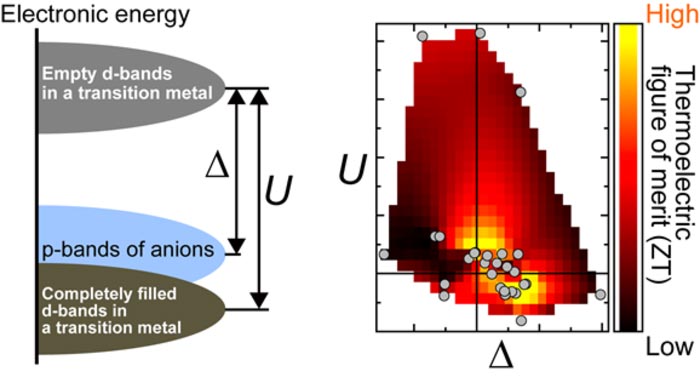New strategy for designing thermoelectric materials

(Left) Schematic diagram explaining two electronic structure parameters: charge transfer energy (Δ) and onsite Coulomb repulsion energy (U). (Right) Plot of Δ and U values indicating areas in which materials with desirable thermoelectric conversion properties can be found.
Credit: Isao Ohkubo National Institute for Materials Science OHKUBO.Isao@nims.go.jp
Electronic structure parameter database can be useful in developing higher performance materials.
The National Institute for Materials Science (NIMS) has succeeded in developing a new approach to the design of thermoelectric materials by constructing a database of electronic structure parameters correlated with materials’ thermoelectric conversion properties and by a comprehensive analysis of the database. This approach can be used to develop higher performance thermoelectric materials.
Thermoelectric conversion is a viable means of harvesting energy to help achieve a low carbon economy and supply electricity to IoT devices—a key digital transformation technology. For these purposes, more efficient thermoelectric materials need to be developed. Thermoelectric conversion is a long-known physical phenomenon: electricity is generated in a solid material with a temperature gradient across it. Extensive efforts have been made to discover highly efficient thermoelectric materials. The conventional approach to developing high-performance thermoelectric materials has been to analyze the electronic structures of materials that exhibit highly efficient thermoelectric conversion and investigate the mechanisms responsible.
These studies have so far focused on the mechanisms of individual materials rather than trying to find commonalities among them. This research group discovered electronic structure properties common to high-performance thermoelectric materials and succeeded in developing a versatile materials design approach.
The research group first constructed a database of two electronic structure parameters known to be correlated with materials’ thermoelectric conversion properties: charge transfer energy (Δ) and onsite Coulomb repulsion energy (U) (see the left-hand diagram in the Figure). Data was collected from various materials containing transition metal ions—a material group in which promising thermoelectric materials have been found in the past. Multiple materials were then simultaneously analyzed using this database, revealing the relationship between various chemical elements and the parameters. Finally, the group applied these relationships to thermoelectric materials and discovered that materials with desirable thermoelectric conversion properties occur in particular areas along the plotted Δ and U values (see the right-hand plot in the Figure).
These results represent a new approach to designing high-performance thermoelectric materials. In addition, the database developed in this project is expected to be useful in research on a wide range of materials (e.g., lithium-ion batteries, catalysts, superconductors and magnetic and ion conducting materials) in addition to thermoelectric materials.
This project was carried out by Isao Ohkubo (Principal Researcher, International Center for Materials Nanoarchitectonics (WPI-MANA), NIMS) and Takao Mori (Group Leader, WPI-MANA, NIMS).
This research was published in the online version of the Journal of the American Chemical Society on February 16, 2022, EST (URL: https://doi.org/10.1021/jacs.1c12520).
Journal: Journal of the American Chemical Society
DOI: 10.1021/jacs.1c12520
Method of Research: Experimental study
Subject of Research: Not applicable
Article Title: Rational design of 3d transition-metal compounds for thermoelectric properties by using periodic trends in electron-correlation modulation Isao Ohkubo* and Takao Mori
Article Publication Date: 16-Feb-2022
All latest news from the category: Materials Sciences
Materials management deals with the research, development, manufacturing and processing of raw and industrial materials. Key aspects here are biological and medical issues, which play an increasingly important role in this field.
innovations-report offers in-depth articles related to the development and application of materials and the structure and properties of new materials.
Newest articles

A universal framework for spatial biology
SpatialData is a freely accessible tool to unify and integrate data from different omics technologies accounting for spatial information, which can provide holistic insights into health and disease. Biological processes…

How complex biological processes arise
A $20 million grant from the U.S. National Science Foundation (NSF) will support the establishment and operation of the National Synthesis Center for Emergence in the Molecular and Cellular Sciences (NCEMS) at…

Airborne single-photon lidar system achieves high-resolution 3D imaging
Compact, low-power system opens doors for photon-efficient drone and satellite-based environmental monitoring and mapping. Researchers have developed a compact and lightweight single-photon airborne lidar system that can acquire high-resolution 3D…





















